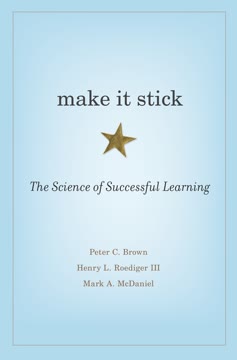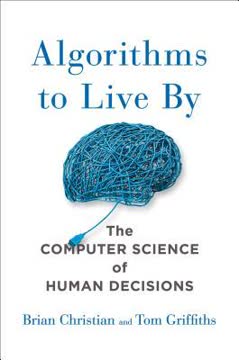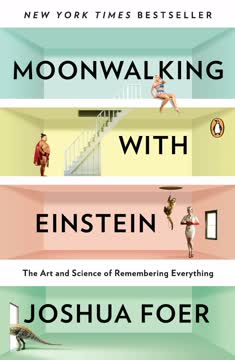Key Takeaways
1. Focused and Diffuse Modes: The Two Essential Thinking Patterns
"Learning involves a complex flickering of neural processing among different areas of the brain, as well as back and forth between hemispheres."
Dual-mode thinking. The brain operates in two distinct modes: focused and diffuse. The focused mode involves concentrated, analytical thinking, while the diffuse mode is more relaxed and allows for broader, creative connections.
Complementary roles. These modes work together to solve problems and learn new concepts. The focused mode is essential for grappling with specific details and working through step-by-step processes. The diffuse mode, on the other hand, helps in understanding the big picture and making unexpected connections.
Practical application. To leverage both modes effectively:
- Alternate between periods of intense focus and relaxation
- Use techniques like the Pomodoro method (25 minutes of focused work followed by a short break)
- Engage in activities that promote diffuse thinking, such as taking walks or exercising
- Allow time for "incubation" of ideas by stepping away from a problem and returning to it later
2. Chunking: Building Neural Patterns for Mastery
"Chunks are pieces of information that are bound together through meaning."
Neural efficiency. Chunking is the process of grouping individual pieces of information into larger, meaningful units. This allows for more efficient storage and retrieval of information in the brain.
Building chunks. To create effective chunks:
- Focus your attention on the information you want to chunk
- Understand the basic idea
- Gain context by seeing how the chunk fits into the bigger picture
- Practice recalling the information from memory
Practical benefits. Chunking:
- Frees up working memory space
- Enables faster problem-solving
- Facilitates transfer of knowledge to new situations
- Helps build expertise in a subject
3. Procrastination: Understanding and Overcoming the Habit
"Procrastination is like addiction. It offers temporary excitement and relief from boring reality."
Root causes. Procrastination often stems from:
- Discomfort or anxiety associated with a task
- Poor time management skills
- Perfectionism
- Lack of clear goals or priorities
Breaking the cycle. To overcome procrastination:
- Use the Pomodoro technique to break work into manageable chunks
- Create a daily to-do list and prioritize tasks
- Develop a routine and stick to it
- Reward yourself for completing tasks
- Practice self-compassion and avoid negative self-talk
Zombie habits. Recognize that procrastination is often a habitual response. By understanding the cue-routine-reward cycle of habits, you can rewire your brain to replace procrastination with more productive behaviors.
4. Practice and Repetition: Strengthening Neural Connections
"Practice helps build strong neural patterns—that is, conceptual chunks of understanding."
Deliberate practice. Effective learning requires purposeful, focused practice that targets specific areas of weakness. This type of practice:
- Pushes you just beyond your current abilities
- Provides immediate feedback
- Requires full attention and effort
Spaced repetition. Distribute your practice over time rather than cramming. This approach:
- Strengthens neural connections more effectively
- Improves long-term retention
- Allows for the consolidation of information during sleep
Active recall. Instead of passively reviewing material:
- Test yourself regularly
- Attempt to explain concepts in your own words
- Apply knowledge to new situations or problems
5. Memory Techniques: Enhancing Retention and Recall
"The memory palace technique involves calling to mind a familiar place—like the layout of your house—and using it as a sort of visual notepad where you can deposit concept-images that you want to remember."
Visualization power. The brain has a remarkable capacity for visual and spatial memory. Leveraging this ability can significantly enhance learning and recall.
Effective techniques:
- Memory Palace: Associate information with specific locations in a familiar space
- Mnemonics: Create acronyms, rhymes, or phrases to remember lists or concepts
- Visual metaphors: Create vivid, memorable images to represent abstract ideas
- Mind mapping: Organize information visually to show relationships between concepts
Practical application. When studying:
- Create visual representations of key concepts
- Use color-coding and diagrams
- Practice mentally "walking through" your memory palace
- Combine multiple senses (visual, auditory, kinesthetic) for stronger memory formation
6. Interleaving: Mixing Up Your Learning for Better Results
"Interleaving means practice by doing a mixture of different kinds of problems requiring different strategies."
Beyond repetition. While repeating the same type of problem can build initial understanding, interleaving different types of problems or concepts leads to deeper, more flexible learning.
Benefits of interleaving:
- Improves ability to discriminate between problem types
- Enhances transfer of knowledge to new situations
- Prevents illusions of competence from repeated success with one problem type
- Mimics real-world application of knowledge
Implementation strategies:
- Mix problem types within a study session
- Alternate between related subjects (e.g., algebra and geometry)
- Revisit previously learned material alongside new concepts
- Create practice sets that require identifying the appropriate technique for each problem
7. Test-Taking Strategies: Maximizing Performance Under Pressure
"Testing isn't just a means of measuring how much you know. Testing in itself is a powerful learning experience."
Test preparation. Effective strategies include:
- Regular self-testing throughout the learning process
- Simulating test conditions during practice
- Reviewing and understanding mistakes from practice tests
- Focusing on areas of weakness
During the test:
- Use the "Hard Start-Jump to Easy" technique: Begin with difficult problems, but quickly move to easier ones if you get stuck
- Manage time effectively, allocating more time to high-value questions
- Use deep breathing and positive self-talk to manage anxiety
- Double-check answers, looking for common mistakes
Post-test learning. After the test:
- Review and understand any mistakes
- Identify patterns in errors to guide future study
- Celebrate successes and progress, regardless of the final score
8. The Value of Struggle: Embracing Challenges in Learning
"Mistakes are inevitable. To work past them, start early on your assignments and, unless you are really enjoying what you are doing, keep your working sessions short."
Productive failure. Struggling with difficult concepts or problems is a natural and necessary part of the learning process. It:
- Builds stronger neural connections
- Enhances problem-solving skills
- Develops perseverance and resilience
Growth mindset. Embrace challenges as opportunities for growth rather than threats to your abilities. This mindset:
- Encourages effort and persistence
- Reduces fear of failure
- Promotes a love of learning
Strategies for productive struggle:
- Start assignments early to allow time for difficulties
- Seek help when truly stuck, but not before attempting the problem yourself
- Reflect on the learning process, not just the outcome
- Celebrate progress and small victories along the way
9. Sleep and Exercise: Vital Components of Effective Learning
"Sleep has been shown to make a remarkable difference in people's ability to figure out difficult problems and to find meaning and understanding in what they are learning."
Sleep's role in learning:
- Consolidates memories and strengthens neural connections
- Clears toxins from the brain that accumulate during wakefulness
- Enhances problem-solving abilities through diffuse mode thinking
Exercise benefits:
- Increases blood flow to the brain, improving cognitive function
- Stimulates the growth of new neurons (neurogenesis)
- Reduces stress and improves mood, enhancing learning capacity
Practical tips:
- Prioritize consistent, quality sleep (7-9 hours for most adults)
- Exercise regularly, even short bursts of activity can be beneficial
- Review difficult material before sleep to enhance problem-solving
- Consider "active recall" during light exercise, like walking
10. Metaphors and Analogies: Powerful Tools for Understanding
"Metaphors and physical analogies form chunks that can allow ideas even from very different areas to influence one another."
Cognitive bridges. Metaphors and analogies connect new, abstract concepts to familiar, concrete ideas. This process:
- Facilitates understanding of complex topics
- Enhances memory and recall
- Promotes creative problem-solving
Creating effective metaphors:
- Identify the key aspects of the concept you're trying to understand
- Find a familiar object or process with similar characteristics
- Draw explicit connections between the familiar and the new
Examples in science:
- Electricity as water flowing through pipes
- DNA as a blueprint for building proteins
- The solar system as a model for atomic structure
Practical application. When learning new concepts:
- Actively seek or create metaphors and analogies
- Discuss and refine these comparisons with peers
- Use visual representations to reinforce the connections
- Be aware of the limitations of any metaphor or analogy
Last updated:
FAQ
What's A Mind for Numbers about?
- Focus on Learning Techniques: A Mind for Numbers by Barbara Oakley explores effective strategies for mastering math and science, emphasizing the importance of understanding how the brain learns.
- Cognitive Science Insights: The book delves into cognitive science, explaining how focused and diffuse modes of thinking affect problem-solving and creativity.
- Practical Applications: Oakley provides practical advice and techniques, such as chunking and retrieval practice, to help students overcome challenges in math and science.
Why should I read A Mind for Numbers?
- Overcome Math Anxiety: The book offers strategies to build confidence and improve skills in math and science, making it ideal for both enthusiasts and those who fear these subjects.
- Empowerment Through Knowledge: It empowers readers by teaching effective learning methods, making the process more enjoyable and less stressful.
- Research-Based Techniques: Oakley’s methods are grounded in cognitive science, providing evidence-based strategies for better academic performance.
What are the key takeaways of A Mind for Numbers?
- Two Modes of Thinking: Understanding focused and diffuse thinking is crucial for effective learning, with focused thinking being analytical and diffuse thinking allowing for creative insights.
- Chunking Information: The book emphasizes chunking, which involves grouping information into manageable units to enhance memory and understanding.
- Retrieval Practice: Engaging in self-testing and retrieval practice is more effective than passive studying methods, strengthening memory and understanding.
How does A Mind for Numbers define focused and diffuse thinking?
- Focused Thinking: This is the concentrated, analytical mode used for problem-solving and understanding specific concepts.
- Diffuse Thinking: A more relaxed, creative mode that allows for broader connections and insights, often activated when the mind is at rest.
- Balancing Both Modes: Oakley emphasizes the importance of alternating between these modes to enhance problem-solving abilities and foster creativity.
What are some effective study techniques from A Mind for Numbers?
- Pomodoro Technique: Involves working in focused bursts followed by short breaks, helping maintain concentration and reduce burnout.
- Memory Palace Technique: Uses visualization to associate information with specific locations, enhancing recall by tapping into spatial memory.
- Active Recall: Actively recalling information strengthens neural connections and improves retention, achievable through self-quizzing or teaching others.
How does A Mind for Numbers address procrastination?
- Understanding Procrastination: Oakley explains that procrastination often stems from discomfort with a task, and recognizing this can help develop strategies to overcome it.
- Habit Formation: Discusses how habits can be harnessed to create productive routines by identifying cues and rewards.
- Practical Strategies: Techniques like the Pomodoro method and setting specific goals encourage focused work sessions and manageable task lists.
What is the significance of chunking in A Mind for Numbers?
- Definition of Chunking: Chunking is the process of grouping information into larger, meaningful units, making it easier to remember and understand complex concepts.
- Building Expertise: Creating a library of chunks improves problem-solving skills and intuition in math and science, allowing for quicker recall during tests.
- Steps to Chunking: Oakley outlines steps for effective chunking, including working through problems, taking breaks, and revisiting material to reinforce understanding.
What are some effective memory techniques mentioned in A Mind for Numbers?
- Chunking Information: Breaking down complex information into smaller, manageable pieces allows the brain to process and remember information more efficiently.
- Spaced Repetition: Reviewing material at increasing intervals helps reinforce memory and prevents forgetting, making it a powerful tool for long-term retention.
- Visual Imagery: Using visual metaphors and stories enhances memory by creating vivid mental images, aiding in the recall of information.
What are some common misconceptions about learning math and science discussed in A Mind for Numbers?
- Illusions of Competence: Many students believe they understand material simply by rereading it, but true understanding requires active engagement and recall.
- Fixed Mindset: The book challenges the notion that some people are inherently "bad at math," arguing that skills can be improved with the right techniques and mindset.
- Overemphasis on Memorization: While memorization is important, understanding concepts is crucial for applying knowledge effectively, focusing on comprehension rather than rote memorization.
What are the best quotes from A Mind for Numbers and what do they mean?
- “Being good at science and mathematics isn’t just something you are; it’s something you become.”: Highlights that skills in math and science can be developed through practice and effective learning strategies.
- “The Law of Serendipity: Lady Luck favors the one who tries.”: Emphasizes the importance of effort and persistence in learning, increasing the likelihood of success and unexpected discoveries.
- “Procrastination is the death of success.”: Underscores the detrimental effects of procrastination on academic performance, serving as a reminder to take control of one’s habits to achieve goals.
How can I apply the concepts from A Mind for Numbers to my studies?
- Implement Study Techniques: Use techniques like the Pomodoro method and active recall in study sessions to stay focused and improve retention.
- Create a Chunked Library: Build a library of chunks as you learn new concepts, enhancing problem-solving abilities and making studying more efficient.
- Reflect on Your Learning: Regularly assess understanding and adjust study habits as needed, using insights from the book to create a personalized learning strategy.
What is the significance of Santiago Ramón y Cajal in A Mind for Numbers?
- Neuroscience Pioneer: Cajal is recognized as the father of modern neuroscience, illustrating the importance of persistence and adaptability in learning.
- Learning from Failure: His journey highlights that even those who struggle can achieve greatness through hard work and dedication, serving as inspiration for learners.
- Creativity in Science: Oakley emphasizes Cajal’s creative approach, showing that imagination and curiosity are vital components of learning, with his ability to visualize complex concepts being a key lesson.
Review Summary
A Mind for Numbers receives praise for its practical advice on learning math, science, and other subjects effectively. Readers appreciate the clear explanations of learning techniques, brain function, and study habits. Many wish they had this knowledge earlier in their education. The book is seen as valuable for students, professionals, and anyone seeking to improve their learning skills. Some criticize the book for being too general or repetitive, but most find it insightful and applicable to various fields beyond just math and science.
Similar Books









Download PDF
Download EPUB
.epub digital book format is ideal for reading ebooks on phones, tablets, and e-readers.








